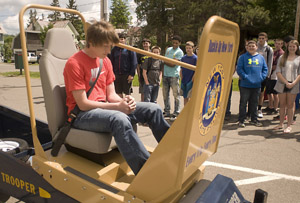
May 23, 2015
Healthy choices driven home for McGraw students

Bob Ellis/staff photographer
Bradley Fuller, a junior at McGraw High School, comes to a sudden stop Friday as he rides “The Convincer,” a state police device that stops suddenly to show passengers the effects of a collision at 7 to 10 mph. It was part of an event at the school sponsored by the Cortland County Health Department.
McGRAW — Car crashes are the No. 1 killer of teens in New York, but wearing a seat belt can make the difference between life and death in a serious car accident. This is just one of the healthy decisions that McGraw High School students were encouraged to make on Friday during a car-crash simulation.
The Cortland County Health Department, along with state police and the faculty of McGraw High School organized a car crash simulation for the students leading into Memorial Day weekend and the district’s senior prom.
The demonstration culminated a week of programs at the school focused on making healthy decisions. The event is part of the National Transportation and Highway Safety Administration’s “Teen Crashes Got to Go” campaign, which coincides with the national “Click It or Ticket” campaign.
Friday’s demonstration featured two devices, a seat belt “convincer” and a rollover simulator.
Students over the age of 14, with permission from their parents, were able to experience the impact of a slow-moving crash not exceeding 10 mph in the convincer, while the rollover simulator demonstrated how quickly an occupant in a vehicle can be ejected if not wearing a seat belt.
State troopers Brian Gurnsey and Quinten Giles emphasized that even one passenger without a seat belt can threaten the lives of all the passengers in a car.
Gurnsey, a graduate of McGraw High School, said that while he has responded to many serious accidents during his 14-year career in law enforcement, there were few that involved teen drivers.
“It seems that more teens are starting to wear their seat belts,” Gurnsey said.
During the seat belt convincer demonstration, Giles showed the students the proper way to fasten their seat belts over their shoulder, instead of under their arm.
“Seat belts are designed as a shoulder harness, not a rib harness,” Giles told the students, adding that he once responded to a car accident in which a woman lacerated her liver and received internal bleeding because her seat belt was pulled across her stomach.
Young drivers face five risk factors, according to Tirzah Tucci-Kamps, who organized the event for the county health department. Impaired driving, distracted driving, not wearing seat belts, inexperience and the number of passengers all heighten the risk of a teen car crash.
“Every passenger in the car increases the odds of a teen crash by about 100 percent,” Tucci-Kamps said.
McGraw senior David Harbey was the first student to enter the seat belt convincer. He said he had been in a car accident before, though like the simulation, it was a slow-moving collision.
Both Harbey and junior Brad Fuller, who also tried the seat belt convincer, said they are not concerned about their classmates’ safety while driving because they don’t know of anyone who neglects to wear a seat belt, or worse, drives drunk.
While the rollover simulator initially prompted laughs from the students, once the crash dummy that was positioned behind the steering wheel began to spin uncontrollably in the cab of the vehicle, the students’ tone became more serious.
“If you do enough, something is going to work,” said Jenny Tucker, McGraw high school’s health teacher. Tucker said the community makes tremendous efforts to keep its youths safe and informed about healthy choices, including an all-night post-prom party at Greek Peek resort.
Cortland Area Communities that Care and Cortland Prevention Resources also participated in Friday’s event, informing students about the marketing techniques used by tobacco companies to lure young consumers, and about the growing problem with gambling among youths.
“We wanted to make this event about teens making all types of healthy choices,” Tucci-Kamps said.
Eighteen percent of Cortland County youths have smoked cigarettes in the last 30 days, according to Sara Watrous of Cortland Area Communities that Care, citing the annual youth survey the organization conducts. However, Potter added that only 10 percent of youths surveyed reported that they expect to be a smoker inadulthood.
“If you think of all the teens who will be on the road over the next four days, we hope with our efforts here this week that they will think of their safety as they drive,” Tucci-Kamps said, adding that all occupants in a vehicle, regardless of age or where they sit in a vehicle, must wear seat belts.
To read this article and more, pick up today's Cortland Standard
Click here to subscribe